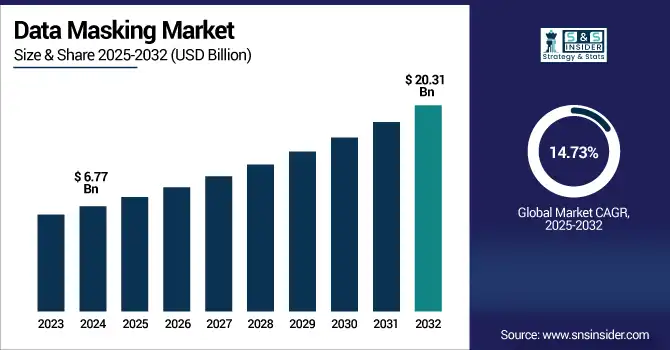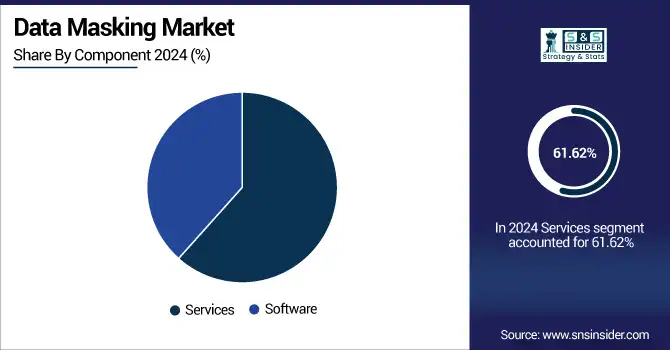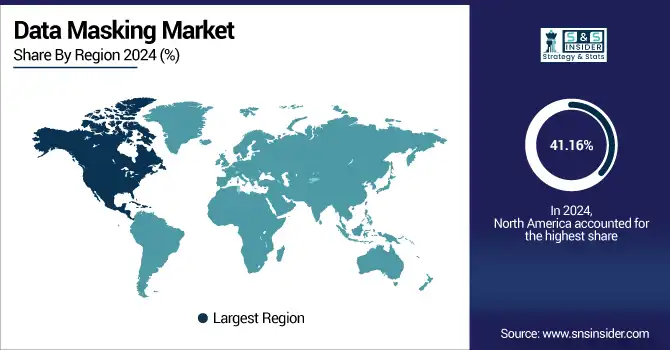Data Masking Market Report Scope & Overview:
The Data Masking Market size was valued at USD 6.77 billion in 2024 and is expected to reach USD 20.31 billion by 2032, expanding at a CAGR of 14.73% over the forecast period of 2025-2032.

To Get more information on Data Masking Market - Request Free Sample Report
Rise of the Data Masking Market. The demand for data privacy and data security is getting priority among the organizations is helping the Data Masking market to gain widespread adoption. Data masking enables static obfuscation of data, replacing real data with plausible, but not real, data, and thereby helps in adhering to regulations like GDPR and HIPAA. Some of the core elements are software, services, and dynamic data masking, which recently became a hot topic with real-time protection. North America is dominating the market on account of superior cybersecurity infrastructure and strict regulations, while Asia Pacific is the fastest-growing region on the back of increasing digital penetration. Europe, Latin America and the Middle East & and Africa also have potential for growth as data protection becomes a worldwide focus.
More than 68% of organizations deploy Data Masking specifically in non-production environments, including testing and development. This practice can decrease testing environments delivery time by 35–45% and decrease insider data misuse events by 40%.
The U.S Data Masking Market size reached USD 1.99 billion in 2024 and is expected to reach USD 5.55 billion in 2032 at a CAGR of 13.72% from 2025 to 2032.
The U.S. dominates the market primarily due to the advanced technological infrastructure, strong data privacy laws such as HIPAA and CCPA, and elevated cybersecurity awareness among organizations within the country. The growing requirement to safeguard sensitive data against breaches, the expanding adoption of cloud computing services, and surging demand for digital transformation within sectors such as BFSI, healthcare, and retail are a few of the major factors driving the overall data protection market. Moreover, stringent regulatory compliance and the rise in cyber threats have forced companies to make significant investments in data masking to protect data generated during software development, testing, and analytics without affecting operational capabilities.
Data Masking Market Dynamics
Drivers:
-
Increasing Regulatory Compliance Requirements for Data Privacy and Security Drive Market Expansion.
The increasing focus on data privacy laws like HIPAA, GDPR, and CCPA has strengthened the demand for effective data protection mechanisms. Businesses from all industries are implementing data masking software to meet these strict regulations, securing sensitive data during development, testing, and analytics processes. Current trends indicate heightened regulatory monitoring and high fines for data breaches, prompting companies to give utmost importance to data masking. Moreover, the growth of cloud adoption and remote workspaces has increased the vulnerability of data further, further increasing the need for data masking technologies as a pivotal security layer. Although the use of data masking is advantageous, its deployment is hindered by its high costs and technical challenges.
Restraints:
-
High Implementation Costs and Complexity Limit Wider Adoption of Data Masking Solutions.
Small and medium-sized businesses tend to struggle to justify the expenditure entailed in setting up and sustaining data masking solutions. Legacy system integration can also be heavy on resources, possibly affecting the performance of systems. The operational overhead is increased by the requirement for trained staff to handle such solutions. These elements combined hold back data masking market growth, especially among price-conscious organizations, to slow general adoption in spite of increased demand for data protection. Cloud platform migration, coupled with advancements in AI and machine learning, is opening new paths towards innovation in data masking.
Opportunities:
-
Emerging Cloud-Native and AI-Driven Data Masking Solutions Present Significant Growth Opportunities.
Cloud-native data masking products provide scalable, adaptable security designed for dynamic environments, and AI improves automation in discovering sensitive data and creating effective masks. Intelligent masking algorithms that adjust in real time have been latest developments, minimizing manual effort. It is in line with increasing demand for efficient, transparent data protection in multi-cloud and hybrid infrastructures, creating lucrative opportunities for vendors to fulfill changing enterprise needs. The scarcity of skilled cybersecurity professionals is a major hurdle in the effective deployment and management of data masking solutions.
Challenges:
-
Lack of Skilled Cybersecurity Professionals Challenges Effective Implementation and Maintenance of Data Masking.
Organizations find it difficult to recruit and retain data protection technology skilled talent, resulting in inefficient implementation and compromised security. Also, limited awareness and knowledge of benefits of data masking slow down organizational investment and adoption. This skills shortage disallows prompt updates, configuration, and maintenance of masking tools, which affects their overall efficiency in safeguarding sensitive information. Overcoming this issue necessitates enhanced training, education, and awareness programs in industries.
Data Masking Market Segmentation Analysis
By Component
The Services segment has the highest revenue share of 61.62% in 2024 due to increasing demand for professional and managed services to deploy, customize, and manage data masking solutions. Players such as Oracle and Informatica have introduced consulting and managed security services to enable enterprises to integrate masking technology with current IT infrastructure seamlessly. These services resolve intricate regulatory compliance requirements while providing continuous protection for data. The dominance of the segment is also strengthened by increasing cybersecurity challenges, compelling organizations to outsource talent for effective data masking deployment and management in the growth-oriented market.
The Software segment is expected to have the fastest CAGR of 15.59% as a result of increased usage of sophisticated, automated data masking software. Recent product releases by vendors such as Delphix and Solix Technologies incorporate AI-driven masking software that provides superior accuracy and decreases manual labor. This development is driven by the need of enterprises to invest in scalable, intuitive software solutions to safeguard sensitive information in hybrid and cloud environments. The software market's aggressive growth indicates the market's transition towards consolidated, adaptable data masking solutions that allow organizations to address dynamic data privacy needs efficiently.

By Business Function
The Legal Finance Operations business leads with 36.46% revenue share in 2024 on the back of the imperative necessity for securing sensitive legal and financial information. Vendors like Broadcom and Innovative Routines International have released industry-specific data masking products designed for financial reporting and regulatory requirements. The segment's growth is fueled by strict data protection regulations and the complexity of financial transactions that necessitate strong data masking to avoid breaches. The dominance of this sector points to the market's emphasis on obtaining mission-critical business processes that process highly sensitive information.
The Sales and Marketing sector is witnessing the fastest CAGR of 14%, driven by the growing usage of customer data analytics and digital marketing campaigns. Companies are implementing data masking solutions for safeguarding consumer data as well as analyzing data for campaign targeting. New releases from vendors such as Oracle and Informatica provide masking tools embedded within marketing analytics platforms. This growth reflects the market's reaction to data privacy issues in data-driven marketing, with compliance ensured using sensitive data for business intelligence and tailored customer experiences.
By Type
Static Data Masking has the largest market share of 55.37% in 2024 due to its consistency in permanently anonymizing copies of sensitive data used for testing and development. Firms such as Solix Technologies and Delphix have extended their static masking solutions with automated workflows and compliance. The dominance of the segment stems from the requirement to secure data at rest without affecting system performance, especially in regulated sectors. The strong position of this reliable and secure method of masking continues to remain so for environments where permanent protection of data is essential, affirming its dominance within the market.
Dynamic Data Masking is expected to advance at the fastest CAGR of 15.39% due to surging demand for real-time data protection during live database queries. Product innovations by firms like Broadcom and Informatica have brought in AI-powered dynamic masking solutions that offer on-the-fly data obfuscation without compromising user access or system latency. It is fueled by businesses needing context-aware, flexible data security solutions that evolve with shifting access permissions and reduce risk exposure in dynamic environments. The widespread adoption of dynamic masking underscores its importance in protecting sensitive information in contemporary, agile IT environments.
Data Masking Market Regional Analysis
North America leading region with a Data Masking Market share of 41.16%, owing to the location of top tech data masking market companies and strict data privacy laws such as CCPA and HIPAA. The region enjoys high usage of cloud computing and sophisticated cybersecurity infrastructure, fueling demand for effective data masking solutions in multiple industries.
The United States is the largest in North America because it has a robust IT industry, an early embracer of data protection technologies, and full regulatory regimes, which make it a central destination for data masking innovation and implementation.
Growth of Europe's Data Masking Market is driven by the strict enforcement of data protection regulations like GDPR. Growing awareness of data privacy and investment in digital transformation within banking, healthcare, and government sectors is a major driver for market growth.
Germany dominates the European market with its highly developed industrial base and effective compliance with data privacy regulations, promoting extensive adoption of data masking technologies.
Asia Pacific is experiencing high growth at a CAGR of 16.59% in data masking as a result of the growing digitization, escalating cybersecurity threats, and growing IT infrastructure in countries such as China, India, and Japan. Cloud adoption in the Asia Pacific and data privacy regulation are major drivers for growth.
China leads the Asia Pacific region, fueled by its enormous digital economy, government policies on data security, and huge investments in leading-edge masking technologies.
The Middle East & Africa and Latin America markets are seeing rapidly rising demand for data masking due to expanding awareness of data security, regulatory changes, and emerging cyber threats. Investments in digital infrastructure, cloud computing, and cybersecurity are fueling market growth. The United Arab Emirates is ahead in the Middle East because of forward-thinking IT policies and a robust finance sector, while Brazil is the powerhouse in Latin America through its huge economy, digital pursuits, and tightening data protection laws.

Get Customized Report as per Your Business Requirement - Enquiry Now
Key Players
The major key players of the Data Masking Market are ARCAD Software, Broadcom, Inc., Delphix, Ekobit d.o.o., Informatica, Inc., Innovative Routines International, Inc., Mage Data, Oracle Corporation, Solix Technologies, Inc., Net 2000 Ltd., and others.
Key Developments
-
In October 2023, Informatica rolled out its Dynamic Data Masking Platform, which allows real-time masking of sensitive data in cloud and on-premises infrastructures. The platform prioritizes zero-trust architecture and helps automate compliance reporting to address changing data privacy laws.
-
In November 2023, Broadcom introduced the Scalable Masking capability in its Test Data Manager, empowering organizations to automate and speed data masking processes, thus adequately responding to increasing data volumes and stringent project timelines in enterprise environments.
| Report Attributes | Details |
|---|---|
| Market Size in 2024 | USD 6.77 Billion |
| Market Size by 2032 | USD 20.31 Billion |
| CAGR | CAGR of 14.73% From 2025 to 2032 |
| Base Year | 2024 |
| Forecast Period | 2025-2032 |
| Historical Data | 2021-2023 |
| Report Scope & Coverage | Market Size, Segments Analysis, Competitive Landscape, Regional Analysis, DROC & SWOT Analysis, Forecast Outlook |
| Key Segments | •By Component (Services, Software, Managed Services, Professional Services) •By Business Function (Sales And Marketing, Human Resources, Legal Finance Operations) •By Type (Dynamic Data Masking, Static Data Masking) |
| Regional Analysis/Coverage | North America (US, Canada, Mexico), Europe (Germany, France, UK, Italy, Spain, Poland, Turkey, Rest of Europe), Asia Pacific (China, India, Japan, South Korea, Singapore, Australia, Rest of Asia Pacific), Middle East & Africa (UAE, Saudi Arabia, Qatar, South Africa, Rest of Middle East & Africa), Latin America (Brazil, Argentina, Rest of Latin America) |
| Company Profiles | ARCAD Software, Broadcom, Inc., Delphix, Ekobit d.o.o., Informatica, Inc., Innovative Routines International, Inc., Mage Data, Oracle Corporation, Solix Technologies, Inc., Net 2000 Ltd. |

